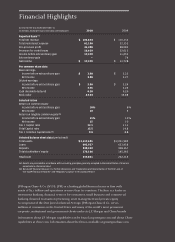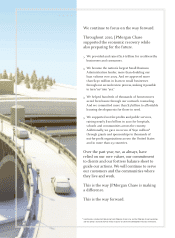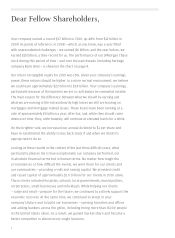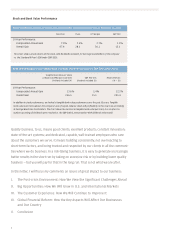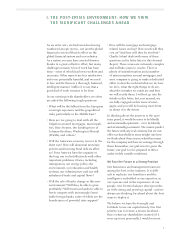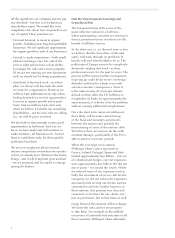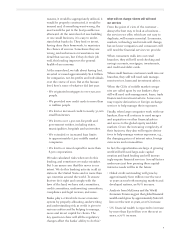JP Morgan Chase 2010 Annual Report Download - page 10
Download and view the complete annual report
Please find page 10 of the 2010 JP Morgan Chase annual report below. You can navigate through the pages in the report by either clicking on the pages listed below, or by using the keyword search tool below to find specific information within the annual report.
8
been focusing on recently. Consumers are
getting stronger, spending at levels similar to
those two-and-a-half years ago, but, instead of
spending more than their income, they now
are saving 5% of their income. And consumer
debt service costs, i.e., how much they spend
of their income to service their debt, have
returned to levels seen in the 1990s (due to
debt repayment, charge-os and debt forgive-
ness,lowerinterestrates,etc.).
Businesses, large and small, are getting
stronger. Large companies have plenty of
cash. Medium sized and small businesses are
in better financial condition and are starting
to borrow again. Global trade is growing –
U.S.exportswereup16%in2010.Jobgrowth
seems to have begun. Financial markets are
wide open – and banks are lending more
freely.U.S.businesses,largeandsmall,are
investing more than $2 trillion a year in
capital expenditures and research and devel-
opment. They have the ability to do more,
and, at the end of the day, the growth in the
economy ultimately is driven by increased
capital investment.
The biggest negative that people point
to is that home prices are continuing to
decline, new home sales are at record lows
and foreclosures are on the rise. Our data
indicates that the rate of foreclosures will
start to come down later this year. Approxi-
mately 30% of the homes in America do
not have mortgages – and of those that do,
approximately 90% of mortgage-holding
homeowners are paying their loans on time.
Housingaordabilityisatanall-timehigh.
TheU.S.populationisgrowingatover3
million a year, and those people eventually
will need housing. Additionally, the fact
that fewer homes are being built means that
supply and demand will come into balance
sooner than it otherwise would have. That
said, housing prices likely will continue to
go down modestly because of the contin-
uous high levels of homes for sale. The ulti-
mate recovery of the housing market and
housing prices likely will follow job growth
and a general recovery in the economy.
Yes, America still is facing headwinds and
uncertainties – including abnormal monetary
policy and looming fiscal deficits. And while
we can’t really predict what the economy will
do in the next year or two (though we think
itisgettingstronger),wearecondentthat
the world’s greatest economy will regain its
footing and grow over the ensuing decade.
But we must take serious action to ensure our
success in the decades ahead
Whileourcondenceinthenextdecade
is high, for America to thrive after that,
it soon must confront some of the serious
issuesfacingit.Weneedtoredoubleour
eorts to develop an immigration policy
and a real, sustainable energy policy;
protect our environment; improve our
education and health systems; rebuild
our infrastructure for the future; and find
solutions for our still-unbalanced trade
and capital flows.
The sooner we address these issues, the
better – America does not have a divine
right to success, and it can’t rely on wishful
thinking and its great heritage alone to
get the country where it needs to go. But
I remain, perhaps naively, optimistic. As
WinstonChurchilloncesaid,“Youcan
always count on Americans to do the right
thing – after they’ve tried everything else.”
Will the Role of Banks Change in This New
Environment?
Banks serve a critical function in society,
but it often is dicult to describe that func-
tioninbasicterms.WhenIwastravelingin
Ghana with one of our daughters (yes, the
same daughter who asked me what a finan-
cialcrisiswasthreeyearsago),shepointed
out all the buildings and projects that had
been started but never finished.
All the money that went into Ghana’s
unfinished buildings was needlessly wasted
and, in fact, had damaged the citizens of
the country. This sorry sight provided me
with a concrete example of how to describe
what banks actually should do. I explained
to our daughter that had banks (or inves-
tors)beendoingtheirjob,theywouldhave
made sure that before money was invested
in a project or enterprise, it had good pros-
pects of success: It would be built for good


